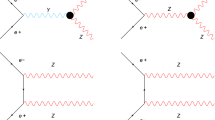Abstract
The production of charmed mesons\(\mathop {D^0 }\limits^{( - )} \),D ±, andD *± is studied in a sample of 478,000 hadronicZ decays. The production rates are measured to be
where the errors from this analysis are separated from those coming from theD branching ratios (BR). TheD *± momentum distribution is extracted separately for\(Z \to c\bar c\) and\(Z \to b\bar b\) events with the help of event shape variables. It is consistent with the prediction of the JETSET Monte Carlo program after adjustment of the charm fragmentation function. Constraining the shape of the\(Z \to b\bar b\) contribution, the average fraction of the beam energy taken by aD * meson produced in the fragmentation of a charm quark is extracted by a parametric fit to be <X E > c =0.495±0.011±0.007. Evidence forD **0 (D 1(2420)0 and/orD *2 (2460)0) production is found in the\(D^{* \pm } \pi ^ \mp \) channel, accounting for a fraction (18±5±2)% of allD *± production. The relative production of vector and pseudoscalar mesons is dicussed, together with the possible effects ofD ** production. Thec-quark forward-backwardZ-pole asymmetry is detrmined from that of high momentumD *± to beA 0,c FB =(7.7±4.4)%.
Similar content being viewed by others
References
D. Buskulic et al., ALEPH Coll.: Phys. Lett. B307 (1993) 194; P. Abreu et al., OPAL Coll.: Phys. Lett. B312 (1993) 181; P.D. acton et al., OPAL Coll.: Phys. Lett. B307 (1993) 247
D. Buskulic et al., ALEPH Coll.: in preparation
D. Decamp et al., ALEPH Coll.: Phys. Lett. B266 (1991) 218
D. Decamp et al., ALEPH Coll.: Nucl. Instrum. Methods A294 (1990) 121
G. Batignani et al.: Conference Record of the 1991 IEEE Nuclear Science Symposium, 1991, Santa Fe, USA
W. Atwood et al.: Nucl. Instrum. Methods A306 (1991) 446
W. Wiedenmann: Nucl. Instrum. Methods A323 (1992) 213
D. Decamp et al., ALEPH Coll.: Z. Phys. C53 (1992) 1
T. Sjöstrand, M. Bengtsson: Comput. Phys. Commun. 46 (1987) 43
D. Buskulic et al., ALEPH Coll.: Z. Phys. C55 (1992) 209
C. Peterson, D. Schlatter, I. Schmitt, P.M. Zerwas: Phys. Rev. D27 (1983) 105
ALEPH Coll.: ‘Heavy Flavour Physics with Leptons’, Contributed paper to the XXVIth International Conference on High Energy Physics Held in Dallas, Texas, 1992, AIP Conference Proceedings, R. Schwitters (ed.). New York 1993
V.G. Kartvelishvili et al.: Phys. Lett. B78 (1978) 615; Yad. Fiz. 38 (1983) 1563
P. Collins, T. Spiller: J. Phys. G11 (1985) 1289
S. Stone: talk presented at the 5th International Symposium on Heavy Flavour Physics. Montreal, 1993; M. Thulasidas: thesis submitted in Syracuse University (1993)
D. Buskulic et al., ALEPH Coll.: Phys. Lett. B313 (1993) 549
Jets are reconstructed with the scaled-invariant-mass clustering algorithm [18]. • variable 1 is the sum of the squared transverse momenta of the particles in the jet with respect to the jet axis of the most energetic jet in the hemisphere [19] P. Henrad: University of Clermont-Ferrand preprint PC/CF RI 88-08. • variable 2 is the momentum of the leading particle of the most energetic jet with respect to the jet axis in the hemisphere [19] P. Henrad: University of Clermont-Ferrand preprint PC/CF RI 88-08. • variable 3 is the boosted sphericity 14-1 of the most energetic jet in the hemisphere. • variable 4 is the product of the sum of the transverse momenta by the sum of the longitudinal momenta normalized toP 2 total • variable 5 is the invariant mass of the three most energetic particles in the most energetic jet in the hemisphere [20] L. Bellantoni et al.: Nucl. Instrum. Methods A310 (1991) 618. • variable 6 to 9 are the directed sphericities described in [20] L. Bellantoni et al.: Nucl. Instrum. Methods A310 (1991) 618
W. Bartel et al., JADE Coll., Z. Phys. C33 (1986) 23
P. Henrad: University of Clermont-Ferrand preprint PC/CF RI 88-08
L. Bellantoni et al.: Nucl. Instrum. Methods A310 (1991) 618
T. Butler et al., CLEO Coll.: Phys. Rev. Lett. 69 (1992) 2041
Particle Data Group: Phys. Rev. D45 (1992)
H. Albrecht et al., ARGUS Coll.: Phys. Rev. Lett. 56 (1986) 549; J.C. Anjos et al., Tagged Photon Coll.: Phys. Rev. Lett. 62 (1989) 1717; H. Albrecht et al., ARGUS Coll.: Phys. Lett. B211 (1989) 422; H. Albrecht et al., ARGUS Coll.: Phys. Lett. B232 (1989) 398; P. Avery et al., CLEO Coll.: Phys. Rev. D41 (1990) 774
P. Abreu et al., DELPHI Coll.: CERN PPE/93-70
F. Hinode et al., VENUS Coll.: Phys. Lett. B313 (1993) 245
M. Artuso et al., CLEO Coll.: Phys. Rev. Lett. 62 (1989) 2233; H. Albrecht et al., ARGUS Coll.: Phys. Lett. B 192 (1987) 245
D. Decamp et al., ALEPH Coll.: Phys. Lett. B258 (1991) 236
M. Martinez et al.: Z. Phys. C49 (1991) 645
G. Altarelli, B. Lampe: Nucl. Phys. B391 (1993) 3
R. Akers et al., OPAL Coll.: CERN-PPE/93-149 (1993), submitted to Z. Phys. C
Author information
Authors and Affiliations
Consortia
Additional information
Supported by CICYT, Spain
Supported by the National Science Foundation of China
Supported by the Danish Natural Science Research Council
Supported by the UK Science and Engineerig Research Council
Supported by the US Department of Energy, contract DE-AC02-76 ER 00881
Supported by the US Department of Energy, contract DE-FG05-92 ER 40742
Supported by the US Department of Energy, contract DE-FC05-85 ER 250000
Supported by the Bundesministerium für Forschung und Technologie, Fed. Rep. of Germany
Supported by the Direction des Sciences de la Matière, C.E.A.
Supported by Fonds zur Förderung der wissenschaftlichen Forschung, Austria
Supported by the US Department of Energy, grant DE-FG03-92 ER 40689
Partially supported by Colciencias, Colombia
Rights and permissions
About this article
Cite this article
ALEPH Collaboration., Buskulic, D., De Bonis, I. et al. Production of charmed mesons inZ decays. Z. Phys. C - Particles and Fields 62, 1–14 (1994). https://doi.org/10.1007/BF01559519
Received:
Issue Date:
DOI: https://doi.org/10.1007/BF01559519




